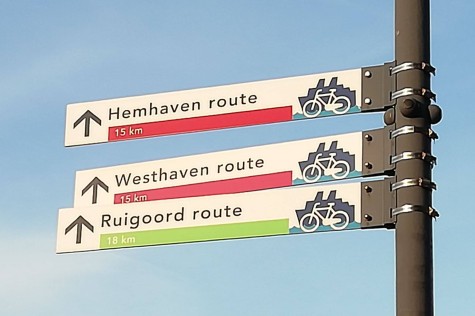Hemhaven route
During this route you cycle along enormous mountains of 'dry bulk'. What they are, you discover on the way. But you will also pass places where bank swallows and peregrine falcons nest. From tough to primeval!
Practical information
- Length: 15 km
- Starting point: Amsterdam Sloterdijk station
- Route: follow the signs from the cycle path at Orlyplein
- End point: Amsterdam Sloterdijk station

What you'll see along the way
Prefer a shorter or longer route?
Stadhaven route
Length: 5 km
Highlights: mix of shipping, business and city life
Westhaven route
Length: 15 km
Highlights: proof of circular economy, gasoline storage tanks
Ruigoord route
Length: 18 km
Highlights: artist village Ruigoord, centuries-old duck decoy
Bank swallows
The bank swallows have a nice piece of real estate at their disposal in the port of Amsterdam. On the Nieuwe Hemweg, against the quay of the North Sea Canal, Port of Amsterdam constructed a wall of bank swallows in 1996.
Such a wall is in fact a concrete wall with holes in it. Behind the concrete there is sand with a little loam through it - soft yet firm. That's perfect for the bank swallow, because he likes to dig a nesting hole in a bank to build a nest in. Something which, with all the paved quays in the harbour, was of course an impossible job for a pair of swallows with a chick wish.
Therefore a kind of swallow condo, with holes in which nests are made every year. You can't see that from the quay, because there are bushes around it, like blackthorn and sea buckthorn. This way the swallows can hatch their eggs undisturbed.
Every year about 10 to 20 breeding pairs nest in the swallow wall. Above the water of the North Sea Canal, they catch insects. Bank swallows are also active around Afrikahaven. Here, the banks are deliberately kept steep and free of vegetation, so that they can nest there too.
750 years of Amsterdam port
The port of Amsterdam originated as early as the thirteenth century. Goods such as beer, grain, wood, herring, wool and salt were loaded and unloaded on the Damrak. Initially only for transport within the Netherlands, but soon the port was also internationally important.
In the Golden Age (the 17th century) Amsterdam was even the most important port in the world. The port provided us with the first exotic products in the Netherlands, such as spices, porcelain, sugar, tobacco and cocoa.
After a low point in French times, at the end of the 18th century, the port revived with the construction of the Noordhollandsch Kanaal in 1824 and the North Sea Canal in 1876. At the end of the nineteenth century, the port expanded, with the Eastern Docklands and the first western ports.
After the Second World War, more and more port basins were added towards the west, because at that time more and more oil, grains, coal and ores were traded. Later on, cruise shipping and container transport were also added. And so we come to today. The port is now a trading centre where all types of transport come together: water, road, rail and air.
Hembrug terrain
Originally an artillery and ammunition factory stood here. The location was carefully chosen behind the defensive line of the Defence Line of Amsterdam.
Nowadays it is an area where markets, festivals, photo exhibitions and concerts take place. And you can dive into the history of the terrain by visiting the Hembrug Museum. It has all the ingredients for a great day out.
Take the ferry to the other side and see what there is to do!
Coal transhipment (OBA)
In the OBA Bulk Terminal Amsterdam the OBA Group processes dry bulk goods. These are large quantities of unpacked goods such as coal, metal, biomass and animal feed. The terminal has existed since 1954.
As a society we are in the middle of the energy transition: the transition to sustainable energy.
This terminal is visible proof of that enormous change. Nowadays, this terminal still mainly processes coal. In 2030, the terminal will look completely different. Then it will be other bulk goods, such as biomass.
Peregrine falcons
There are two towers in this area where every year a pair of peregrine falcons breed a nest. And that's special, because this bird of prey was on the brink of extinction until a few years ago. This was mainly due to a certain type of agricultural poison, which was banned at the end of the last century. Since then, fortunately, the number of peregrine falcons has increased again.
The Hemweg power station and AEB Amsterdam both have a tower with a nesting box on top. These nesting boxes can be recognised by a grid protruding from the chimney.
That's how you find them:
Hemweg power station: when you're standing on Nieuwe Hemweg, facing the power station, it's the tower on the left.
AEB Amsterdam: if you're on Australiëhavenweg, facing the power station, it's the rear tower.
This bird of prey is the fastest bird in the world! Opinions about its top speed vary - from 200 to 260 km per hour. Peregrine falcons only breed at high altitudes, normally on high rocks. But these high towers are an excellent alternative.
Kissing Couple
The video is in Dutch.
Lookout Zaandam
Here the port of Amsterdam is adjacent to the port of Zaandam. The port of Zaandam is also centuries old and is connected to a number of real classics in the Dutch business world: Bruynzeel and Verkade. Traditionally, wood and cocoa arrived in the port of Zaandam. That's why the kitchen builder and the chocolate factory also settled nearby.
We work intensively with the port of Zaandam. For example, we work together to ensure that the surrounding area does not suffer from noise or odour from both ports.
We also divide the number of river cruise ships between the ports of Amsterdam and Zaandam. This means that Zaandam, too, benefits from the activity and employment generated by the mooring of such a cruise ship.
